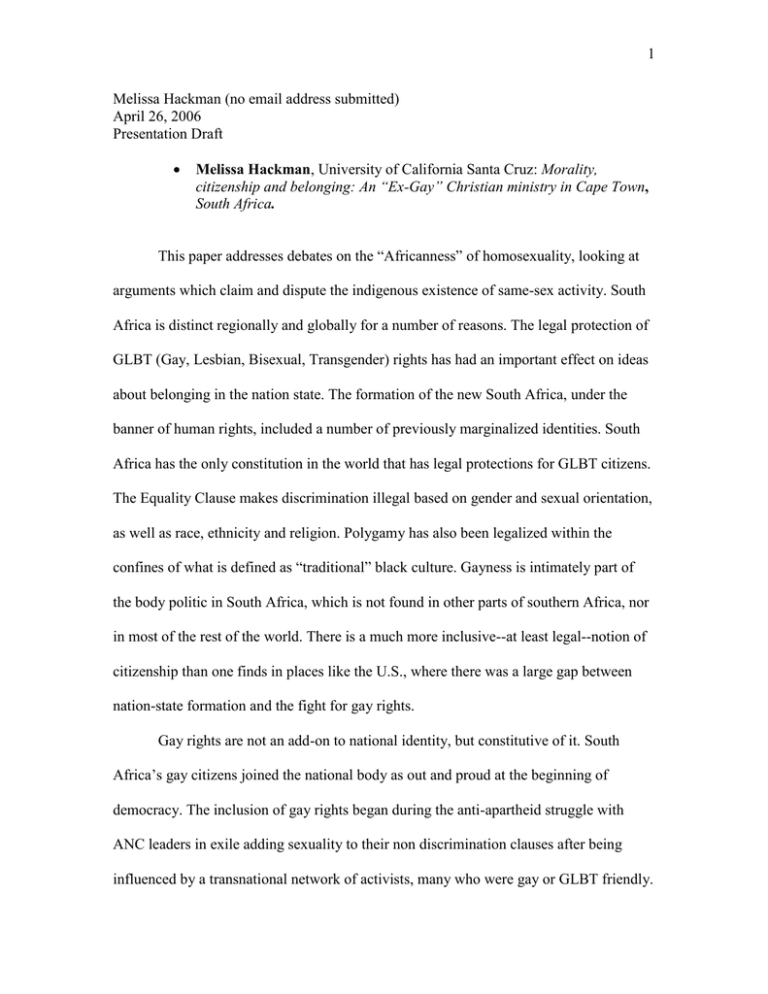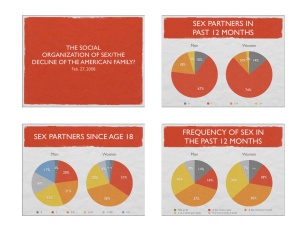
1
Melissa Hackman (no email address submitted)
April 26, 2006
Presentation Draft
Melissa Hackman, University of California Santa Cruz: Morality,
citizenship and belonging: An “Ex-Gay” Christian ministry in Cape Town,
South Africa.
This paper addresses debates on the “Africanness” of homosexuality, looking at
arguments which claim and dispute the indigenous existence of same-sex activity. South
Africa is distinct regionally and globally for a number of reasons. The legal protection of
GLBT (Gay, Lesbian, Bisexual, Transgender) rights has had an important effect on ideas
about belonging in the nation state. The formation of the new South Africa, under the
banner of human rights, included a number of previously marginalized identities. South
Africa has the only constitution in the world that has legal protections for GLBT citizens.
The Equality Clause makes discrimination illegal based on gender and sexual orientation,
as well as race, ethnicity and religion. Polygamy has also been legalized within the
confines of what is defined as “traditional” black culture. Gayness is intimately part of
the body politic in South Africa, which is not found in other parts of southern Africa, nor
in most of the rest of the world. There is a much more inclusive--at least legal--notion of
citizenship than one finds in places like the U.S., where there was a large gap between
nation-state formation and the fight for gay rights.
Gay rights are not an add-on to national identity, but constitutive of it. South
Africa’s gay citizens joined the national body as out and proud at the beginning of
democracy. The inclusion of gay rights began during the anti-apartheid struggle with
ANC leaders in exile adding sexuality to their non discrimination clauses after being
influenced by a transnational network of activists, many who were gay or GLBT friendly.
2
This legalization and enshrinement of gay rights in the founding documents of
democratic South Africa has been supported in the past decade with laws making it
equally possible for gay men and women to adopt children, seek visas for non-native
partners- and in an enormous legal victory last year- the courts decided that the
government had twelve months to put measures into effect to make gay marriage legal.
Partly due to the publicness of sexual identity, as well as the explosion of sexual
discourses after apartheid, sexuality and sex are public in ways that are unique to the
South African context. For example, the government has its own HIV/AIDS prevention
program, lovelife, that asks youth to make informed sexual decision and have safe sex.
Paying particular attention to the political and scholarly literature on the
“Africanness” or “unAfricaness” of homosexuality, I want to draw attention to both sides
of this debate and look at the stakes in claims of indigenous homosexuality. Because of
time constraints, below I am mostly touching on literature that has to do with black men,
although there is an emerging literature on lesbianism in South Africa and southern
Africa regionally.
Marc Epprecht presents the argument that although we may not find same-sex
identities as we understand them in southern Africa today, there were black Africans
participating in same-sex activities in the pre-colonial and colonial periods. General
social norms about not discussing sex or turning a blind eye to sexual activity outside of
reproduction (sex that did not lead to reproduction did not count as sex since it was
divorced from fertility) are used as evidence to prove that homosexual activities were not
contextually alien. “De facto tolerance” led to “indigenous cultures of discretion” where a
3
cultural focus on propriety and respectability meant that sexuality in general was not
discussed (Epprecht 1998b).
In records from 1921 the “native custom” dictated that attempted sodomy
warranted a fine of one animal. Contextually, this level of fine is in the category of a
misdemeanor, and was not as serious as punishments for alleged female adultery which
when prosecuted led to the payment of ten to twelve animals (Epprecht 1998a). The first
sexual offense crimes Africans were tried for in colonial courts were for homosexual
sodomy, not heterosexual rape. Epprecht’s point is that homosexual acts were invisible to
neither Africans nor Europeans in the early years of direct rule. His focus on the
beginning of colonialism is strategic, helping to prove his thesis of indigenous African
same-sex activity. Colonizers therefore brought homophobia, not homosexuality with
them (Kendall 1999).
The existence of indigenous terms for same-sex sexual activity are used in
arguments to prove homosexuality as African and not something that came from the West
or outside African influences. The existence of local indigenous words for same-sex
activities is one of the criterion used to judge the cultural normality of these actions
and/or identities contextually. For example, although its current use is primarily insulting
in Tanzania there is a word in Swahili for lesbian, msagaji, translated as “grinder” that is
used to describe sexual activities between women (Mohamed with Wieringa 2005).
The “Africanness” of homosexuality is also discussed in literature on tinkonkana
(mining wives) in the gold mines outside of Johannesburg during the 20th century.
Usually called “circumstantial or situational homosexuality,” these practices are
presented in most of the literature as restricted to conditions where women are absent.
4
According to some writers becoming an inkotshame (mining wife) was part of an
initiation from boy to manhood. Being a “wife” involved performing sexual and domestic
tasks for “husbands.” Looking like a woman in appearance was important, so “wives”
would alter their appearance in non-permanent ways. This included shaving to have a
smooth chin or covering up that part of their face, as well as dressing in feminine
clothing. Almost all of this same-sex behavior is claimed as interfemoral or intracrural
sex, with friction and ejaculation between the thighs.
T. Dunbar Moodie’s functionalist work is the most cited in the literature on
mining wives (tinkonkana). He argues that men who chose or were coerced into mine
marriages did so because they were rewarded financially for their domestic and sexual
duties, allowing them accrue more money to take back with them to rural areas. Mining
marriages are discussed as a way to resist becoming a proletariat, since miners saved their
pay to return to their “homeland,” not to become urbanites (Moodie et al 1988). His
argument is also based on the fact that tinkonkana are said to have died out by the 1970s
due to changes in the economy of desire, socio-political situations including the violence
of the anti-apartheid movement, rise of African nationalism, as well as an influx of
women into the vicinity of mining compounds.
It is important to note, however, that one form of sexual activity does not mean
others are not taking place. Having a “wife” on the mines did not mean that one had no
other source of sexual release. Daniel (a pseudonym) and a friend had girlfriends in the
township, but told an interviewer “we never slept in the township, we just took a few
hours with our girlfriends and then went back to the boys. We loved them better”
(Ndatshe 1993: 48). The willing participation of black Africans in these same-sex
5
practices and relationships, as well as the claim that folks at home also knew about them
and accepted their presence, are used as further proof of the Africaness of homosexuality.
Since so many men are claimed to have been aware of these sexual acts and relationships,
as well as participated through migrant labor and also time in apartheid era prisons, they
are again read within arguments for the “Africanness” of homosexuality as part of known
sexual expressions and again just not something that was openly discussed.
For those who posit homosexuality as “unAfrican,” it is a white western import
that came with colonialism and polluted African traditions. Claimed to not be indigenous
to Africa, homosexuality, was one more dimension of the colonial project to take over
black cultures. President Mugabe of Zimbabwe has claimed that homosexuals are “worse
than pigs and dogs” and stated in 1995 “Let the Americans keep their sodomy, bestiality,
their stupid and foolish ways to themselves... Keep those out of Zimbabwe...We do not
want those kinds of behavior in our country”
The above mentioned mining marriages are also used as a key example by those
who see homosexuality as profoundly unAfrican. The link between the beginnings of
black homosexual activities with oppressive and gender segregated apartheid era labor
and political practices are seen by many, including black nationalists, as proof of how the
perversion of apartheid became embodied in sexual practices. Men who were unable to
bring their families with them to mining camps are presented in this literature as having
to “make do” with men posing as women sexually and domestically. The arguments
above that see biological men becoming social females as part of a fluidity of sexual
identities and the possibility of changes in sexual activities over time are read here as
emerging because they were as close as men could get to having a traditional relationship
6
with women when they were absent. Of course, the above quote about having access to
multiple sexual partners across gender and “loving the boys better” would be read as part
of the effects and contagion of apartheid. Homosexuality is also seen within this
framework as becoming a viable and desperate option because the worsening of black
economies led to the delay or even inability for black men to pay lobola (bride-price),
support a family and establish a household.
As both sides of the debate note, the men and women who drastically changed
sexual practices (those physically confined in mining compounds, prisons and labor
camps) were the most “emasculated” and “detribalized.” Underlying these arguments are
ideas about what constitutes “real” Africaness- here the rural, links between masculinity,
family provision and patriarchal power and connections and accountability to elders and
ancestors. Men who have sex with men in this framework were forced into European and
“non-traditional,” thus unnatural, norms of behavior by either lack of options or from the
dehumanization of labor practices that led to increases in “vice” and crime, especially
having to do with sex.
Of note in trying to understand discourses on the African-ness of homosexuality is
that the sides are often drawing on the same data, i.e. the mining marriages, although
drawing very different conclusions. What we find is agreement on changes in sexual
activities and identities from apartheid, in particular migrant labor practices, but
disagreement on the morality of these acts and how much choice was involved.
Discussions about homosexuality as “forced” or imported denies the fluidity of sexuality
and gender, as well as the ability of Africans to incorporate, change and also be changed
by contact with whites and Africans from other places. This denies the possibility of
7
same-sex behavior to include love and general feelings of affection, which reinscribes
racist colonial ideas of black Africans as oversexed and not able to make conscious
sexual choices. In their work on the interactions between Tshidi Zionists and nonconformist British missionaries, the Comaroffs are clear about both colonized and
colonizer both being changed in the colonial and missionary encounter. New hybrid
cultural forms emerged that conformed to neither strict colonial nor Tswana pre-colonial
norms. The same argument about the agency of Africans in creating new forms of culture
can be made about changes in South African sexual practices and identities. Debates on
the “Africanness” of homosexuality lock Africans into static definitions of personhood
and community and deny Africans the ability to change as part of what is “African.”



